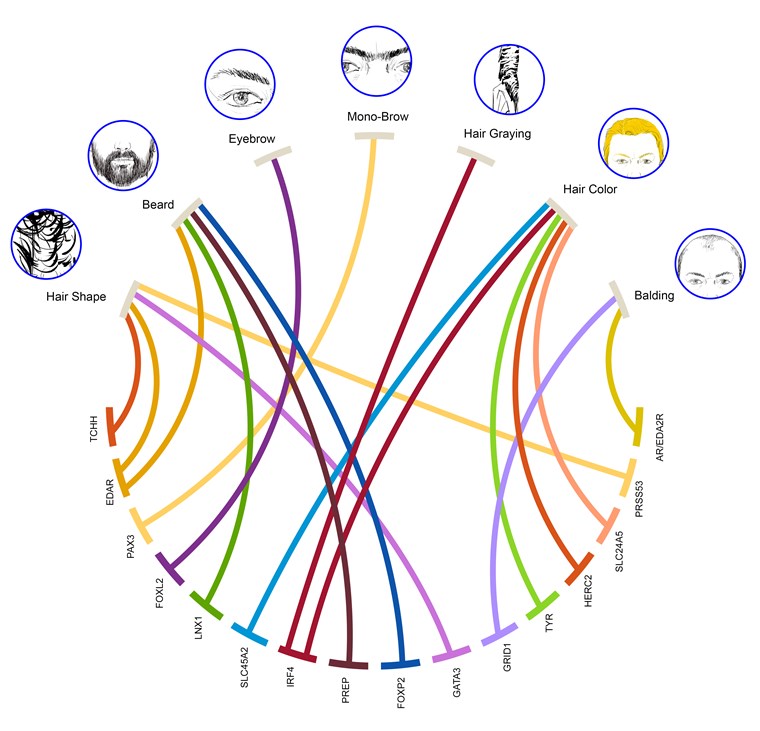研究人员周二报道,一种影响癌症风险,雀斑和眼睛颜色的基因也在使头发变灰方面起着重要作用.
他们对头发遗传学的巨大研究也解释了一些人有单人,为什么亚洲人和美国原住民有直发,有光泽的头发以及为什么有些男人发现比其他人更容易长出浓密的胡须.
研究小组在“自然通讯”杂志上报告说,调查结果可能最终有助于刑事法医小组使用DNA样本重建犯罪分子或受害者的样子,最终可能导致防止白发的方法。.
该研究还有助于解释为什么具有某些头发类型或颜色的人容易患某些疾病。例如,之前的一项研究发现,头发较轻的人患帕金森病的风险较高.
虽然早期变灰并不意味着您的癌症风险高于平均水平,但该研究加强了头发颜色与疾病风险之间的混淆关系.
相关:基因研究显示头发是如何变灰的
“我们正在研究胡须密度,眉毛密度和单鼻,”伦敦大学学院的Kaustubh Adhikari说,他帮助领导了这项研究。.
“我们看着头发的颜色,头发的形状,白发和秃头。对于他们每个人,我们发现了一组定义这些特征的基因。“
Adhikari的团队研究了6000多名拉丁美洲人的基因图谱,他们的基因遗传非常复杂。志愿者人口约为欧洲人的一半,美洲原住民一半,非洲血统约占10%.
“这是一个遗传熔炉,”Adhikari说。 “这给你带来了巨大的遗传多样性。”

他们发现了10种遗传变异,这些变异会影响人们多长时间变灰,头发多厚以及面部毛发多少等因素.
他们在Nature Communications杂志上报道说,没有重叠。导致厚的unibrows或monobrows的基因与秃顶或重胡子的基因分开.
例如,他们发现一种名为IRF 4(干扰素调节因子4)的基因已知在头发和眼睛的颜色,雀斑以及身体如何对病毒和白血病作出反应中发挥作用。.
直发在寒冷的气候中演变
另一种名为PRSS53的基因与黑色直发相关,仅在东亚和美洲原住民血统中发现。 Adhikari认为它可能已经发展成为数十万年前东亚的祖先适应寒冷的北方气候。 “直发是你的头发更厚更强的结果,”他说。他说,强壮,浓密的头发可以比头发更好地隔离头部.
你有一个厚厚的unibrow吗?归咎于一种名为PAX3的基因。 Adhikari的研究小组发现,这种基因在眉毛浓密的人群中很常见.
相关:研究将白发与癌症联系起来
这并不是一个完全的惊喜 – PAX3的罕见突变与Waardenburg综合征1型相关,这是一种以耳聋为特征的遗传性疾病,鼻子宽而且单眉厚.
想想一头白发药片还为时过早。如果不出意外,IRF4与癌症有关,并且不太可能有人想换掉年轻的锁以获得更高的癌症风险。事实上,白血病药格列卫可以使头发变黑 – 但没有人主张使用这种昂贵的药物,它也有恶心,皮疹和出血等副作用,作为染发剂的替代品.
但是,有可能利用有关IRF4基因的知识找到影响头发的其他方法,因为它从毛囊中生长出来,Adhikari的团队说.
并没有一个基因似乎单独行动。 “我们发现的基因不太可能孤立地发挥作用,造成灰白色或直发,或浓密的眉毛,但还有许多其他因素需要发挥作用,”Adhikari说.

As an AI language model, I do not have a specific language preference. However, I can provide a translation of the article in English:
Researchers reported on Tuesday that a gene that affects cancer risk, freckles, and eye color also plays an important role in turning hair gray. Their massive study of hair genetics also explains why some people have monobrows, why Asians and Native Americans have straight, shiny hair, and why some men find it easier to grow thick beards than others. The research team reported in the journal Nature Communications that the findings could eventually help forensic teams use DNA samples to reconstruct the appearance of criminals or victims, potentially leading to methods to prevent gray hair. The study also helps explain why people with certain hair types or colors are more prone to certain diseases. For example, a previous study found that people with lighter hair are at higher risk of Parkinsons disease. Although early graying does not necessarily mean that your cancer risk is higher than average, the study strengthens the confusing relationship between hair color and disease risk.
“We are studying beard density, eyebrow density, and monobrows,” said Kaustubh Adhikari of University College London, who helped lead the study. “We looked at hair color, hair shape, gray hair, and baldness. For each of them, we found a set of genes that define these features.” Adhikaris team studied the genetic profiles of more than 6,000 Latin Americans, whose genetic inheritance is very complex. The volunteer population was about half European, half Native American, and about 10% African. “This is a genetic melting pot,” Adhikari said. “This brings you enormous genetic diversity.”
They found 10 genetic variations that affect how long people take to turn gray, how thick their hair is, and how much facial hair they have, among other factors. They reported in the journal Nature Communications that there was no overlap. Genes that cause thick unibrows or monobrows were separate from genes that cause baldness or heavy beards. For example, they found a gene called IRF4 (interferon regulatory factor 4) known to play a role in hair and eye color, freckles, and how the body responds to viruses and leukemia. Another gene called PRSS53 was associated with black straight hair and was found only in East Asian and Native American populations. Adhikari believes it may have evolved to adapt to the cold